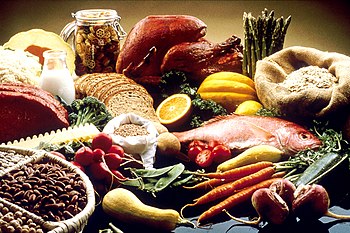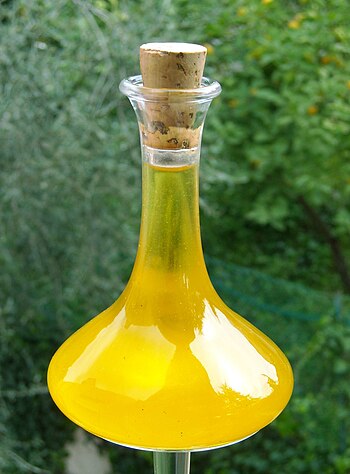As simple concepts go, this is great. But, it leaves a lot of questions unanswered. Where are the oils? What kind of grains should you eat? Are any proteins a good choice? Is milk necessary at every meal - or at all?
By just putting a little more thought into the MyPlate graphic, we can come up with a more detailed nutritional guide. Let's take a look at the divided plate and see how we can improve it.
Vegetables
 |
| A variety of healthy foods. (Photo credit: Wikipedia) |
Fruits
Fill the rest of that half of your plate with brightly colored fruits and berries. You want to choose a wide variety of colors in order to receive lots of nutrients. Bananas and apples are good, but they are not colorful. Branch out beyond these familiar fruits and explore all the colors you can find. Remember, frozen fruit and berries are a healthy option.
Whole Grains
You'll notice we changed the name from the MyPlate group called 'grains.' We want grains to be whole and as unrefined as possible. Limit refined grains (like white bread or white rice) to a bare minimum. An occasional cupcake is fine, but on a daily basis, keep your cereals, breads, pasta, and rice brown and whole for optimum nutrition. Whole grains should make up no more than one-quarter of your plate - and if you (like many Americans) suffer from gluten sensitivity, you will want to avoid whole wheat or any of its derivatives.
Healthy Protein
Again, you'll notice a name change. The food group 'protein' is way too general. You should strictly limit red processed meats such as bacon and cold cuts. Red meat should be consumed in moderation, and ONLY from grass-fed animals - preferably organic. This one-quarter of your plate should be filled mostly with wild-caught fish, grass-fed/pastured poultry, beans, and nuts. Keep your red meat consumption to an occasional treat - and remember to buy grass-fed.
Water
Yes, we've done it again. That glass of milk has been changed to water. It is not that milk should be totally avoided - unless you're lactose-intolerant. However, one or two servings of dairy is sufficient, while water should be on the table at every meal. If you have problems with milk tolerance, you should avoid it altogether. You may also want to have one glass of juice per day, but should avoid sugary drinks, including sugary fruit juices. Vegetable juices are great for your health, and you can add a bit of fruit in for flavor if you like.
 |
| Olive oil from Imperia in Liguria, Italy. (Photo credit: Wikipedia) |
We have actually added a 'food group' to our plate. Now we have a little bottle of oil on the table. This signifies 'healthy oils' that should be included in our diet. Olive oil, coconut oil, or cold-pressed avocado oil are all good to use. Natural animal fats like butter are okay in moderation. You should avoid all highly processed vegetable oils, including cottonseed, soybean, canola, corn, and other such oils, which have been proven to be carcinogenic and very bad for your health. (See our recent post here on which cooking oils you should never use.) Remember, natural is always best! If you can eat an oil that is straight from the source and minimally processed, this is more likely to be a healthy oil.
Stay Active
Many of the earlier food group guidelines added exercise, or staying active, as an important part of healthy living. Eating healthy is only part of the equation. Staying active, having a fitness routine, or just moving around, completes a well-rounded nutrition program, and that is why we added staying active back into our guideline. Check out our Fun Ways to Exercise blog for some helpful tips on quick, fun ways to fit more exercise into your day.
MyPlate is a good tool to get kids and adults thinking about how their meal should look. But, it doesn't go far enough. Each individual should design their own plate with more specific, healthier choices laid out in more detail. You can call it My Own Plate, or My Own Pyramid, or whatever you choose. No matter what you call it, just start making healthier choices now to live a healthier life from now on!
No comments:
Post a Comment
We welcome comments and suggestions!